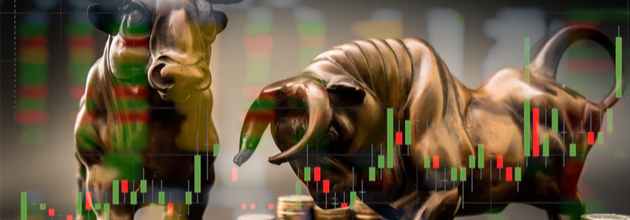Top News  Shutterstock The holiday-shortened week saw tech suddenly back in favor after a first quarter where cyclical and value plays dominated. The Nasdaq, which trailed the major averages in Q1, gained 2.6% for the week, topping the S&P's gain of 1.4% and the Dow, up 0.2%. The megacaps all closed higher, with Tesla the big winner. Treasury yields continued strong moves, making a run above 1.75% on Tuesday and cementing above 1.7% on Friday with their extra day of trading compared with the stock market. The jobs report, which was reported with the stock market closed for the holiday, blew past consensus estimates, with nonfarm payrolls rising 916K in March. The jobless rate dipped to 6% from 6.2% That bodes well for further strong performance in recovery stocks after the March ISM manufacturing index came in at its highest level since 1983. But while rates edged up, financials found themselves on the back foot, with the Archegos blowup hitting not just bottom lines, but raising questions about lax oversight of the dealings with banks and family offices.    | | Top News  Shutterstock The holiday-shortened week saw tech suddenly back in favor after a first quarter where cyclical and value plays dominated. The Nasdaq, which trailed the major averages in Q1, gained 2.6% for the week, topping the S&P's gain of 1.4% and the Dow, up 0.2%. The megacaps all closed higher, with Tesla the big winner. Treasury yields continued strong moves, making a run above 1.75% on Tuesday and cementing above 1.7% on Friday with their extra day of trading compared with the stock market. The jobs report, which was reported with the stock market closed for the holiday, blew past consensus estimates, with nonfarm payrolls rising 916K in March. The jobless rate dipped to 6% from 6.2% That bodes well for further strong performance in recovery stocks after the March ISM manufacturing index came in at its highest level since 1983. But while rates edged up, financials found themselves on the back foot, with the Archegos blowup hitting not just bottom lines, but raising questions about lax oversight of the dealings with banks and family offices.    | |
| Economy Nonfarm payrolls handily topped Wall Street estimates, rising 916K in March, the Labor Department reports, compared with economist forecasts for a rise of around 650K. The jobless rate dipped to 6% from 6.2%, in line with forecasts. The report will be welcome news to those on Wall Street hoping for economic data to start to show concrete results of a strong recovery after the success of the recovery trade in Q1. It's the biggest number of jobs created since August. Revisions to the previous two months also added 156K jobs. Treasury yields edged higher after the report, with the 10-year up 2 basis points, back to 1.7% (NYSEARCA:TBT) (NASDAQ:TLT). The bond market is "correctly focusing on all things that could stir up growth in the longer term" and is "right to be ahead" of the economic figures, but yields could still go higher, Alan Ruskin, chief international strategist at Deutsche Bank, told Bloomberg. Digging further into the report, private sector jobs rose by 780K vs. expectations of 643K. Leisure and hospitality added 280K jobs, with 176K coming from food services and drinking places. Arts, entertainment and recreation added 64K jobs. Labor force participation was a bit of a concern, edging up to 61.5%. That's "suggesting that labor supply may soon become the constraint on this recovery," Julia Pollack, labor economist at ZipRecruiter, tweets. Average hours earnings fell unexpectedly by 0.1% for the month, compared with an expected rise of 0.1%. That could be driven by workers in more lower-wage sectors being hired as areas continue to open up. Wage inflation still looks a long way off. The average hourly work week rose 0.3 hour to 34.9 hours, suggesting employers are still pushing current workers for more. But that could bode well for job gains in future months as that hits a plateau.    | |
| Sponsored By VantagePoint  VantagePoint's A.I. technology can protect your downside risk while helping maximize upside gains. How? This dual-patented artificial intelligence looks at real-time market data to identify only the trends that are built to last. See our FREE live online training this week where VantagePoint experts will demonstrate the A.I. on a stock of your choice! | |
| Stocks The broader market and cyclicals outperformed tech shares in Q1, while bond prices sank and deals had their biggest quarterly performance in 20 years. The S&P (SP500, SPY) is up 5.8% year to date, outpacing the Nasdaq (COMP, QQQ), which rose 2.8%. The Dow (DJI, DIA), with its cyclical tilt to financials and industrials and its price-weighted calculation, rose 7.8% through the first three months. "Given the carnage we saw in some areas of the market recently, it may not seem that way but March was a very positive month for US equities across different styles and sectors," Bespoke Investment Group writes in a note. "At the index level, the Dow led the way surging nearly 7%, but the S&P 500 was also very strong, gaining more than 4.5%. Large Cap Tech was an area of relative weakness, but even the Nasdaq 100 was up 1.71% (just about all of which came on the last trading day of the month)." "Continuing a trend that has been in place all year, value stocks left growth in the dust, more than doubling the gains of growth stocks during March," Bespoke adds. In its review of Q1, DataTrek Research says the outsize moves seen in volatility in previous years are returning to normal at a fairly brisk pace. "Lots of liquidity into the US economy and financial system has helped corporate earnings rebound and valuations stabilize quickly," DataTrek's Jessica Rabe writes. "That, along with a solution to the crisis issue (i.e. vaccines) and lower equity sector correlations, have dampened volatility faster than prior post-crisis periods." Yields take off: One of the big weights on technology and other high-valuation stocks has been the rise in U.S. Treasury yields (TBT, TLT). Treasury prices sank the most since 1980, when the fed funds rate surged in an attempt to curb inflation. The Bloomberg Barclays U.S. Treasury Index is off 4.25% over the past three months. Inflation expectations are a big reason for the rise in yields, with the 10-year breakeven rate approaching 2.4, levels not seen in nearly eight years. "I think yields continue to go up," Bob Parker, senior adviser at Quilvest Wealth Management says. M&A booms: Mergers and acquisitions enjoyed their best performance in two decades in Q1 at $1.1T. A big boon to that activity is SPACs putting money raised to use. The amount reported of public companies buying private companies rose to $435B in Q1, up 86% from the year-ago period, according to a Bloomberg estimate. North America led dealmaking with $644B, followed by Europe at $286B and Asia Pacific at $261B.    | |
| Tech Evercore ISI's quarterly enterprise technology spending survey is pointing to an outlook that's "very strong," with 80% saying they expect to see their IT spending rise and 14% expecting it to stay the same. That's in line with some optimism shown in the November survey - but confidence is higher in these new numbers, with 81% feeling more upbeat with regard to IT spending. The survey encapsulates responses from executives at the VP-or-higher level at large companies with insight into their IT spending process - casting a wider net than just chief information officers in seeking a "bottoms-up" view of the process for a better look. Digging into particulars, Evercore says 88% of respondents agree (strongly or somewhat) that COVID-19 has accelerated their shift to cloud offerings. It says that heading into the bulk of 2021, the top three IT spending priorities are: Service Desk & IT Workflow modernization; Artificial Intelligence; and Infrastructure refresh. As for who's expected most to benefit via a net increase in wallet share from vendors, Microsoft (NASDAQ:MSFT) tops out with 55%, just ahead of Amazon.com (NAAMZN) at 49%. Also doing well on the growing-wallet-share measure: IBM (NYSE:IBM); Zoom (NASDAQ:ZM) at 42%; Oracle (NYSE:ORCL) at 40%. Meanwhile, with offices looking to reopen this year, Evercore says there will be a renewed focus on hybrid/on-premise after 2020's big shift toward the public cloud. In three years, respondents expect the workload mix will be 52% private.    | |
| Sponsored By VantagePoint  | |
| Stocks Archegos Capital, the family office run by Bill Hwang that was pushed to liquidate, was forced to sell more than $20B of stocks after margin calls. Goldman Sachs (NYSE:GS) emailed clients to inform them it was one of the banks selling, detailing a total of $10.5B in trades, though it didn't identify Archegos or Hwang, according to Bloomberg. Deutsche Bank (NYSE:DB), Goldman and Morgan Stanley (NYSE:MS) were identified as those selling black trades. Hwang, a Tiger cub who pleaded guilty to insider trading in 2012 when he worked for Tiger Asia Management, was deemed such a risk that Goldman, as recently as 2018, refused to do business with him, Bloomberg reported. The billions of dollars in block trades included ViacomCBS (NASDAQ:VIAC), Discovery (NASDAQ:DISCA), Baidu (NASDAQ:BIDU) and GSX Techedu (NYSE:GSX). Archegos is estimated to have managed about $10B of personal wealth for Hwang and his family, according to the WSJ. The Archegos fund was highly levered and had very concentrated positions in companies and held some via swaps. The fund was estimated to have had exposure to the economics of more than 10% of multiple companies' shares. Credit Suisse (NYSE:CS) shares tumbled in Swiss trading after the company said it was forced to exit positions after the Archegos fire sale. Some press estimates put Credit Suisse's losses up to $4B, with Nomura up to $2B. JPMorgan estimated total bank losses to be in the range of $5B to $10B.    | |
 U.S. Indices
Dow +0.2% to 33,153. S&P 500 +1.1% to 4,020. Nasdaq +2.6% to 13,480. Russell 2000 +1.5% to 2,254. CBOE Volatility Index -8.1% to 17.33.
S&P 500 Sectors
Consumer Staples -0.8%. Utilities +0.8%. Financials +0.2%. Telecom +3.4%. Healthcare -0.6%. Industrials +0.5%. Information Technology +2.1%. Materials -0.3%. Energy -0.4%. Consumer Discretionary +2.2%.
World Indices
London -0.1% to 6,737. France +1.9% to 6,103. Germany +2.4% to 15,107. Japan +2.3% to 29,854. China +1.9% to 3,484. Hong Kong +2.1% to 28,927. India +2.1% to 50,030.
Commodities and Bonds
Crude Oil WTI +0.5% to $61.3/bbl. Gold -0.1% to $1,730.5/oz. Natural Gas +2.7% to 2.627. Ten-Year Treasury Yield -0.6% to 130.99.
Forex and Cryptos
EUR/USD -0.27%. USD/JPY +0.97%. GBP/USD +0.36%. Bitcoin +6.%. Litecoin +15.1%. Ethereum +23.3%. Ripple +12.3%.
Top Stock Gainers
Wah Fu Education (NASDAQ:WAFU) +117%. Big Rock Partners Acquisition (NASDAQ:BRPA) +41%. Humanigen (NASDAQ:HGEN) +40%. Freightcar America (NASDAQ:RAIL) +39%. Nextdecade (NASDAQ:NEXT) +35%.
Top Stock Losers
Gsx Techedu (NYSE:GSX) -52%. Viacom CBS (NASDAQ:VIAC) -33%. Orphazyme A/S (NASDAQ:ORPH) -31%. Canoo (NASDAQ:GOEV) -30%. Gracell Biotechnologies (NASDAQ:GRCL) -28%.
Where will the markets be headed next week? Current trends and ideas? Add your thoughts to the comments section. | |
|
|---|
| |
|
|
EmoticonEmoticon